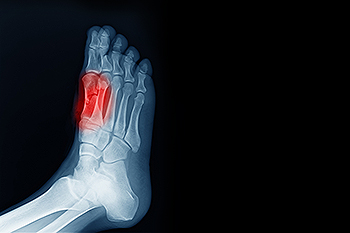- Home
- Our Doctors
- Our Offices
- New Patients
- Patient Education
- Blog
- Contact Us
- Patient Portal Help
- Product Center

Sesamoiditis causes pain in the ball of the foot, specifically under the big toe. The sesamoid bones are located in the tendons of the big toe and may become injured for various reasons. Inflammation can lead to a decreased range of motion, and it is common among people who have sesamoiditis. There are specific stretches and exercises that are helpful in restoring range of motion to a normal level, in addition to strengthening the entire foot. An effective stretch is done by extending the affected leg while sitting down, and curling the big toe under, followed by pulling it back. When the inflammation has mildly subsided, another exercise to perform is done by standing, and rising up on the toes. After holding for several seconds, the number of repetitions can be repeated. If you feel pain or discomfort in the bottom of your foot, please confer with a podiatrist who can determine if it is caused by sesamoiditis and offer correct treatment methods.
Sesamoiditis is an unpleasant foot condition characterized by pain in the balls of the feet. If you think you’re struggling with sesamoiditis, contact one of our podiatrists of Foot & Ankle Institue. Our doctors will treat your condition thoroughly and effectively.
Sesamoiditis
Sesamoiditis is a condition of the foot that affects the ball of the foot. It is more common in younger people than it is in older people. It can also occur with people who have begun a new exercise program, since their bodies are adjusting to the new physical regimen. Pain may also be caused by the inflammation of tendons surrounding the bones. It is important to seek treatment in its early stages because if you ignore the pain, this condition can lead to more serious problems such as severe irritation and bone fractures.
Causes of Sesamoiditis
Treatment for sesamoiditis is non-invasive and simple. Doctors may recommend a strict rest period where the patient forgoes most physical activity. This will help give the patient time to heal their feet through limited activity. For serious cases, it is best to speak with your doctor to determine a treatment option that will help your specific needs.
If you have any questions please feel free to contact one of our offices located in St. George, Hurricane, and Cedar City, UT and Mesquite, NV . We offer the newest diagnostic and treatment technologies for all your foot and ankle needs.
Having issues or need help with your portal?
Click here for Instructional Videos